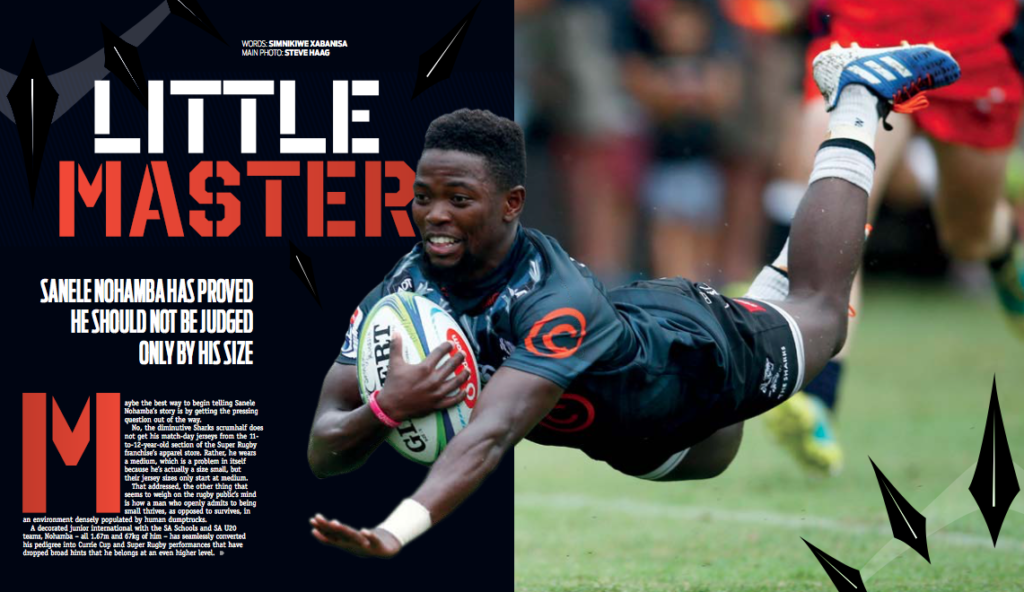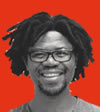Sanele Nohamba has proved that he is a player who cannot be judged by his size, writes SIMNIKIWE XABANISA in the latest SA Rugby magazine.
NEW MAG: What’s in our latest issue?
Maybe the best way to begin telling Nohamba’s story is by getting the pressing question out of the way.
No, the diminutive Sharks scrumhalf does not get his matchday jerseys from the 11 to 12-year-old section of the Super Rugby franchise’s apparel store. Rather, he wears a medium – which in itself is a problem because he’s actually a size small – because their jersey sizes only start at medium.
That addressed, the other thing that seems to weigh on the rugby public’s mind is how a man who openly admits to being small thrives, as opposed to barely surviving, in an environment densely populated by human dumptrucks.
A decorated junior international with the SA Schools and SA U20 teams, Nohamba – all 1.67m and 67kg of him – has seamlessly translated that pedigree into Currie Cup and Super Rugby performances that have dropped broad hints that he belongs at an even higher level.
Whereas in the past a man of Nohamba’s outrageous gifts but negligible size would have been damned with the faint praise of being promised a superstar existence in sevens, the 21-year-old belongs to a new batch of wee fellas – Faf de Klerk, Herschel Jantjies and Cheslin Kolbe come to mind – who punch above their weight and unnerve bigger players in fifteens because they are fleet of foot and mind.
While De Klerk and Kolbe have had to go the tortuous route to finding apposite respect for their ability, Jantjies and Nohamba are the beneficiaries of coaches (the Stormers’ John Dobson and the Sharks’ Sean Everitt) who believe in the strength of a player’s strengths, as opposed to the strength of his weakness, regardless of their size.
And so a career that began with Nohamba typically taking the road less travelled – by making an unpopular decision in high school – has gone on to flourish. Having grown up as a middle-order batsman (No 4) who bowled off-spin, Nohamba’s entire schooling – from Dale Junior in King William’s Town to DHS in Durban – was paid for by cricket scholarships. So for the longest time Nohamba’s envisaged future included answering to the moniker of The Little Master (his physical dimensions are remarkably similar to those of Sachin Tendulkar’s), but he had other ideas, informing DHS three years into his high school years that he would focus on rugby.
‘We had KZN cricket trials when I was 15 and I actually didn’t make it,’ he explains. ‘Then the following year I made the Grant Khomo team and the SA U16 High Performance squad, so that’s how the decision came about. I felt I could make it this side [rugby] as opposed to the other side [cricket].’
‘Also I enjoyed the vibe around rugby more. In cricket, on a Saturday it’s just you and your teammates playing the whole day, whereas rugby’s got a different gees and vibe. The school wasn’t so happy about it but they came to terms with it when I started excelling at rugby.’
The man who was ringside to a lot of that transition, not to mention Nohamba’s permanent move from flyhalf to scrumhalf, and some of the heroics which made him something of a cult figure at DHS, was former Sharks and Bulls scrumhalf Scott Mathie.
Now coaching Griquas, Mathie’s first memory of Nohamba was the youngster being moved from flyhalf to wing when his team was defending, due to his size; something he immediately put an end to as the DHS first-team coach.
‘Because he was small for his age, he wasn’t too keen on the contact so they used to hide him on the wing,’ Mathie says. ‘But I oversaw one training session when he was in Grade 10 and I said to him: ‘No, bru, you’re going to defend there. If they run over you that’s fine but that’s where you’re going to stand’.
‘So we put him in a position where he knew he couldn’t hide and that, coupled with the fact that we started sevens that year, helped him grow in confidence in terms of defence and work rate. Also in sevens, if you miss a tackle it’s a try, so he just stepped up, going from being aware of his size to someone who took responsibility for his channel.’
Mathie says Nohamba’s move from flyhalf to scrumhalf, was necessitated as much by DHS needing all its best players on the park as it was by the fact that they had one eye on where he would need to play at professional level, such was their confidence in his abilities.
Nohamba himself remembers it slightly differently, saying he simply wanted to go back to what he considered his original position.
Despite looking at home at standoff, as was memorably displayed by his seamless deputising for Boeta Chamberlain – who was injured early in the game against the Hurricanes in Wellington this year – Nohamba is in no doubt as to which is his best position.
‘I prefer nine because I’m more in control of everything,’ he says.
In keeping with the Napoleon-esque need to control everything, Nohamba grew up looking up to French scrumhalf Morgan Parra, as opposed to Fourie du Preez like most young scrumhalves would, rounding off the admiration by also kicking for posts.
But if there was a control freak to whom you’d happily hand over the keys of your team, it’s Nohamba.
‘He’s such a natural ball player, he can fill in at 10 and look comfortable; at nine he’s got a great pass, he’s got such incredible acceleration over five to 10 metres and a lethal step,’ Mathie says. ‘His general vision and feel for space are things you can’t really teach; that ability to read games and know where they are going is the reason we always felt he would make it.’
Nohamba dropped some liberal hints as to his once-in-a-generation ability along the way, especially during his last season in high school, where he was part of a DHS team which beat Glenwood for the first time in 10 years, his teammates that day including fellow Sharks Phepsi Buthelezi and Celimpilo Gumede, with JJ van der Mescht featuring for the opposition.
‘He just bossed that game and won us the game,’ says Mathie wistfully. ‘It was a helluva performance away, slotting in a drop goal … he was really special that day.’
Crucially, Nohamba displayed another quality important to making it at the highest level – warrior spirit – when he came back two weeks early from a broken collarbone to score the winning try against Maritzburg College in a year in which he played only four games but still made the KZN Craven Week and the SA Schools teams.
As obvious as his ability was in school, Nohamba still needed one more thing to play first-class rugby, according to Mathie: ‘We never had doubts in him but the problem is when you get an exceptional player who’s not big, as a coach you always fear that they won’t get the chance they deserve once they leave school. Sanele’s the exception to the rule when it comes to the small players, he’s a Kolbe, an Aplon. I never doubted him, but it always depended on whether he would be given a chance.’
The Sharks did just that, and Nohamba – a quietly confident sort who plays with an ever-present smile from living his dream and a reminder to ‘Be Kind’ on his wrist strapping – hasn’t looked back, looking more and more at ease the bigger the games he’s been presented with.
According to insiders at the Sharks, the main reasons for that are a tireless work ethic and turning up mentally switched on for training sessions to the point where he’s always ‘razor sharp’ – his high school nickname – for training.
The quality which has most won his Sharks coaches is his humility and coachability, which has led one of them to say becoming a Springbok is ‘written in the stars, injury permitting’.
Long story short, don’t judge a player by his jersey size…
*This article first appeared in the May issue of SA Rugby magazine, which is now on sale.





